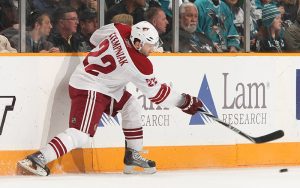With the sports world on hold, Cronkite News will take a daily look at this day in sports history and reflect on some of the biggest moments in Arizona sports.
PHOENIX – On April 10, 2010, the then-Phoenix Coyotes wrapped up the franchise’s best regular season in Arizona, finishing with 107 points after a shootout loss to the Pacific Division-winning San Jose Sharks in the regular-season finale.
Those are just facts in the team’s record book now, but it was an unlikely outcome for a franchise struggling to remain afloat amid a looming bankruptcy, an uncertain ownership situation and the possibility of relocation.
However cloudy the picture appeared off the ice, the Coyotes found refuge inside the boards. Despite the distractions, they qualified for the playoffs for the first time since 2002.
For some of the Coyotes, the team’s first-round series against Detroit marked their first Stanley Cup playoff experience.

“(Dave) Tippett came in and really installed a defensive-minded mentality with his team,” said Craig Morgan, a long-time Coyotes beat reporter who now covers the team for The Athletic. “They relied on the goaltending ability of (IIya) Bryzgalov; they relied on a very good blue line. If you look at what has happened in the NHL, it’s really changed in terms of the complexion of defensive units. That was a physically big unit that played good defense.”
Morgan said the NHL shifted to a more offensive focus not long after that season.
“If you look at today’s NHL, it’s really more about offensive puck movers getting the puck up quickly,” Morgan said. “The league changed only a couple years after that team, but they really stayed true to that (defensive) mentality, defended well and played very close, low-scoring games a lot of the time.”
The team’s defensive culture also was a key to its resiliency. The Coyotes won 14 of 20 games that went to a shootout and won five of six in overtime.
It was Tippett’s first season with the team, and he inherited a roster that was a mix of unknown younger players and veterans. The youth movement included wing Mikkel Boedker and defenseman Keith Yandle. The more notable veterans were wing Shane Doan, defenseman Ed Jovanovski and center Robert Lang.
Defenseman Adrian Aucoin, a 14-year veteran, was nearing the twilight of his career when he signed a one-year free-agent contract with the Coyotes after playing for Vancouver, Tampa Bay, the New York Islanders, Chicago and Calgary. At 36, and with nagging groin and shoulder injuries, Aucoin faced a tough decision.
“I didn’t know how much more hockey I had left in me when free agency rolled in,” he said.
With four kids and another on the way, his decision to go west was not easy, but the idea of playing for Wayne Gretzky, who was beginning his fourth year as the Coyotes’ coach, was appealing. After a brief conversation with then-general manager Don Maloney and some of the team’s players, he decided to sign.
“I talked to Don Maloney, who I’ve always really liked,” Aucoin said. “I didn’t know him at the time, (but) always heard reputable things about him. I knew the team was struggling a little bit, but over the years I’ve kind of gotten to know – not super directly, but – Shane Doan. He was always one of the guys who I’ve really liked.”
Aucoin and right wing Radim Vrbata had played together for two seasons with the Blackhawks and Aucoin had played a season with center Matthew Lombardi in Calgary.
“It was just one of those groups where I looked at the team, and I looked at what their capability was and thought this could be cool,” Aucoin said.
However, he never played for Gretzky, who resigned during training camp and was replaced by Tippett.

The Coyotes’ Lee Stempniak passes the puck during the team’s regular-season finale, against the San Jose Sharks, on April 10, 2010. The team finished with 107 points, the best point total in franchise history. (Photo by Don Smith/NHLI via Getty Images)
But as the season unraveled, more drama, twists and turns arose when trucking mogul Jerry Moyes who had bought the team in 2006, then filed for Chapter 11 bankruptcy in 2009. Not long after, a federal judge approved the sale of the team to the National Hockey League for $140 million to keep it in Arizona.
As the team searched for new owners, things only worsened through a series of court battles and unsuccessful bids. It wouldn’t be until 2013 when IceEdge, a team led by Canadian businessman George Gosbee and Anthony LeBlanc purchased the franchise from the NHL for $170 million.
“They knew they had to have success right away in order to save this franchise,” Morgan said. “They needed to make some money and granite, they were still losing money in those seasons. But they knew they had to do everything they could on the ice to try and save this team.”
It wasn’t long before Aucoin and his teammates were winning games and earning nicknames. Aucoin was dubbed “The Closer” or “Shootout King” because of his adeptness in shootouts despite his position.
During a game at Nashville on Feb. 2, 2010, the Coyotes and Predators played 65 scoreless minutes then battled through nine rounds of a shootout. Tippett called on Aucoin, whose shootout attempts had only been witnessed by his teammates during a friendly competition after practice, and he wristed a laser into the net for the winning goal.
Aucoin backed it up on Feb. 5 in Chicago, using the same shot to score the game-winner and kept the team’s six-game winning streak going.
“It was crazy, Aucoin said. “Just going into the shootouts, our goalies were great like Jason Labarbera; he was an unbelievable backup to (IIya) Bryzgalov that year. Bryzgalov was just a rock star.”
Aucoin would go on to convert his next three attempts and Vrbata converted two, all of which decided games and kept the team’s nine-game winning streak going.
He finished six of nine in shootouts, including an NHL-record for consecutive game-winning shootout goals in one season when he scored his fifth in a row against Dallas in the final victory of the nine-game streak.
It was Vrbata who was best known for his shootout ability, leading media members to refer to his patented attempt as the Vrbackhander.
“Vrbata, he made it look so easy,” Aucoin said. “He’d just go down there, go forehand, backhand and score every time.
“We just had this funny confidence, and I think along with the whole ownership thing and all the turmoil going on with the team, a shootout was almost like another ongoing joke for us, because we already earned the points. Now it’s like, ‘Hey, let’s just get the bonus point. Let’s have fun with it.'”
Although Aucoin never got to play for “The Great One,” he did play for a “pretty good one” in Tippett. He recalls three things that defined Tippett’s tenure – structure, staying calm and being prepared.
Although the Coyotes fell to the Detroit Red Wings in the first round of the 2010 playoffs, due in part to a series-ending shoulder injury to Doan in Game 3, what a free-wheeling bunch of characters was able to accomplish within Tippett’s disciplined culture, and amid all of the distractions surrounding the franchise, remains a remarkable achievement.
“Dave Tippett, to me, really stands out as someone who was the big catalyst for the success that team had that season,” said Sarah McLellan, a former Coyotes beat writer at The Arizona Republic who now covers the Minnesota Wild for the Star Tribune in Minneapolis.
“He came in and brought a sense of stability and composure. He was very calm, cool and collected, and I think that’s probably what the team needed most at that time.”
Edith Noriega is a senior majoring in sports journalism at Arizona State University. This story is a part of a partnership between the Bay Area News Group and Arizona State University’s Walter Cronkite School of Journalism and Mass Communication.
